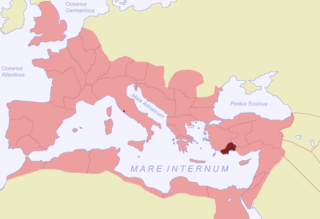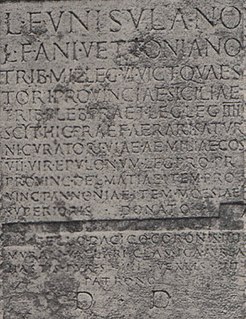Related Research Articles

Marcus Clodius Pupienus Maximus was Roman emperor with Balbinus for three months in 238, during the Year of the Six Emperors. The sources for this period are scant, and thus knowledge of the emperor is limited. In most contemporary texts he is referred to by his cognomen "Maximus" rather than by his second nomen Pupienus.
Gnaeus Julius Verus was Roman senator and general of the mid-2nd century AD. He was suffect consul, and governed several important imperial provinces: Germania Inferior, Britain, and Syria.

Lycia et Pamphylia was the name of a province of the Roman empire, located in southern Anatolia. It was created by the emperor Vespasian, who merged Lycia and Pamphylia into a single administrative unit. In 43 AD, the emperor Claudius had annexed Lycia. Pamphylia had been a part of the province of Galatia.
Titus Pomponius Proculus Vitrasius Pollio was a Roman senator, who held several imperial appointments during the reign of Marcus Aurelius. He was suffect consul in an undetermined nundinium around 151; he was a consul ordinarius in the year 176 with Marcus Flavius Aper as his colleague.

Gaius Caristanius Fronto was a Roman soldier and equites whom Vespasian promoted to the Roman Senate for his loyalty to the latter in the Year of Four Emperors. He was appointed suffect consul in AD 90 as the colleague of Quintus Accaeus Rufus.

Marcus Sedatius Severianus was a Roman senator, suffect consul, and general during the 2nd century AD, originally from Gaul. Severianus was a provincial governor and later a provincial consul. The peak of his career was as suffect consul for the nundinium of July–September 153 as the colleague of Publius Septimius Aper. He was governor of Cappadocia at the start of the Roman war with Parthia, during which he was convinced by the untrustworthy oracle to invade Armenia in 161. Sedatius committed suicide while under siege in the Armenian city of Elegeia, on the upper Euphrates. The legion he led was wiped out shortly after. He was replaced as governor of Cappadocia by Marcus Statius Priscus.
Lucius Antistius Rusticus was a Roman senator active in the later part of the first century AD. He was suffect consul for March to April 90, with Lucius Julius Ursus Servianus as his colleague.

Lucius Funisulanus Vettonianus was a Roman general and senator during the reigns of the Flavian emperors. He was suffect consul in the nundinium of September to October 78 with Quintus Corellius Rufus as his colleague.

Lucius Caesennius Sospes was a Roman senator of the 1st and 2nd centuries AD. Through his mother, Flavia Sabina, a cousin of the Roman emperors Titus and Domitian, his connections enabled him to hold a series of civil and military imperial appointments. He was suffect consul in the nundinium of May to August 114 as the colleague of Gaius Clodius Nummus. Sopses is known primarily from an inscription found in Pisidian Antioch.
Lucius Valerius Propinquus was a Roman senator active in the second century AD. He was suffect consul who replaced the ordinary consul Marcus Annius Verus and was the colleague of the other ordinary consul, Gaius Eggius Ambibulus, for the remainder of the first nundinium of 126.
Pomponius Mamilianus was a Roman senator who held several offices in the service of the emperor. He was appointed suffect consul in the nundinium of May to June 100 as the colleague of Lucius Herennius Saturninus. He is known through surviving inscriptions, and was a correspondent of Pliny the Younger.
Gaius Arrius Antoninus was a Roman senator and jurist active in the last half of the second century AD, who held a number of offices in the emperor's service. The date when he was suffect consul is not attested, but has been estimated to be around AD 173. Edward Champlin includes him, along with Gaius Aufidius Victorinus and Tiberius Claudius Julianus, as "marked out as a special intimate of Fronto's." Champlin notes that while Victorinus received five of the surviving letters of the rhetor Fronto, "as the beloved pupil and son-in-law", Antoninus received four, taking "the place of Fronto's son."
Aulus Claudius Charax was a Roman senator and historian of the second century AD, who held a number of offices in the emperor's service. He served as suffect consul for the nundinium April-June 147 with Quintus Fuficius Cornutus as his colleague. Charax wrote a history, Hellenika, in forty books, of which only fragments survive.
Titus Vibius Varus was a Roman senator who was ordinary consul in AD 134 as the colleague of Lucius Julius Ursus Servianus, the brother-in-law of the emperor Hadrian. He is known from inscriptions and the Digest ; he is also attested by a military diploma, which shows, that he was still in office on April 2, together with Titus Haterius Nepos as his colleague.
Lucius Cossonius Gallus was a Roman senator, who held a number of offices in the imperial service. He was suffect consul in one of the nundinia that fell in the last half of AD 117 as the colleague of Publius Afranius Flavianus. His full name is Lucius Cossonius Gallus Vecillius Crispinus Mansuanius Marcellinus Numisius Sabinus. He is known entirely from inscriptions.
Publius Valerius Patruinus was a Roman senator, who flourished under the reign of Domitian. He was suffect consul in the nundinium of July–August 82 with Lucius Antonius Saturninus as his colleague. He is known entirely from inscriptions.
Quintus Voconius Saxa Fidus was a Roman senator, who was active during middle of the second century. He was suffect consul in the nundinium September-October 146 with Gaius Annianus Verus as his colleague. He is known almost entirely from inscriptions; Voconius is mentioned once in Ulpian's Liber octavus de officio proconsulis.

Titus Pomponius Bassus was a Roman senator who held a number of imperial appointments. He was suffect consul in the nundinium of September–December 94 as the colleague of Lucius Silius Decianus.
Titus Haterius Nepos was a Roman senator and general, who held several imperial appointments during the reign of Hadrian. He was suffect consul in the year AD 134, immediately succeeding Lucius Julius Ursus Servianus as the colleague of Titus Vibius Varus. According to an inscription found in Fulginiae in Umbria, surmised to be his home town, he received triumphal ornaments for an unspecified military victory, as well as attesting his full name is Titus Haterius Nepos Atinas Probus Publicius Matenianus.
Lucius Aninius Sextius Florentinus was a Roman senator, who held a number of imperial appointments during the reigns of Trajan and Hadrian. He died while governing Roman Arabia; his unnamed son had a tomb prepared for him at Petra, which still stands.
References
- ↑ Alison E. Cooley, The Cambridge Manual of Latin Epigraphy (Cambridge: University Press, 2012), p. 469
- 1 2 Rémy, Les carrières sénatoriales dans les provinces romaines d'Anatolie au Haut-Empire (31 av. J.-C. - 284 ap. J.-C.) (Pont-Bithynie, Galatie, Cappadoce, Lycie-Pamphylie et Cilicie) (Istanbul: Institut Français d'Études Anatoliennes-Georges Dumézil, 1989), p. 298
- ↑ Birley, The Fasti of Roman Britain (Oxford: Clarendon Press, 1981), p. 235
- ↑ Notizie degli Scavi di Antichità, 1896-105
- ↑ Eck, "Jahres- und Provinzialfasten der senatorischen Statthalter von 69/70 bis 138/139", Chiron , 13 (1983), pp. 148-152
- ↑ Rémy, Les carrières sénatoriales, p. 297